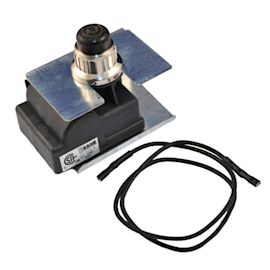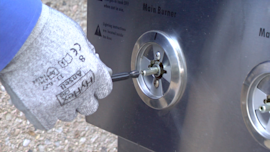How to brine and grill a turkey


Once you’ve grilled a turkey, you may never go back to the oven-roasted variety. Not only does this method produce a moist and flavorful turkey, it leaves your oven free for other cooking and baking.
The secret to a flavorful, moist grilled turkey? Brining—soaking it in salted, flavored water—which makes the turkey plump, seasoned and ready for hours of cooking without drying out.
Plan to soak the turkey in the brine for about 45 minutes per pound of turkey and to grill for about 11 to 13 minutes per pound. For a 15-pound turkey, that's about 11 hours of soaking and 3 hours of grilling.
If you're using a frozen turkey, allow 3 days for it to thaw.
Ingredients
Turkey
Water
Salt
Sugar
Optional: Herbs, peppercorns, star anise, slices of oranges and lemons, or other flavorings
Optional: Apple cider instead of some of the water
Supplies
Roasting pan, stock pot, 5-gallon bucket or other container deep enough to completely hold the turkey
Non-stick cooking spray
Grill scraper/brush
Oven mitts
Aluminum foil
Meat thermometer
Paper towels
Carving board
Chef's knife
1. Prepare the brine
Soaking a turkey in brine—salt water—makes the turkey plump, seasoned and juicy, even after hours on the grill.
The amount of brining solution to mix depends on the size of the turkey and the shape of the brinig container—you need enough brining solution to completely cover the turkey. For a 12-pound turkey that's just a little smaller than its container, a good starting point is to mix 1 gallon of water, 2 cups sugar and 1/2 cup table salt.
You can substitute apple cider for some of the water, to add flavor. You also can add flavoring such as sliced fresh lemons and oranges, peppercorns, star anise or herbs.
Tip: You can heat the water to make it easier to dissolve the sugar and salt, and to release the essential oils in the flavorings. Then let it cool—don’t place the turkey into hot brine.
2. Place the turkey in the brine
Remove the neck and giblets from both ends of the turkey—save them for making gravy, if you like.
Rinse the turkey with water and place it the brining container. Pour the brine over the turkey. Add more water as needed to completely cover the turkey. Place the bird in the fridge or other cold place—but not so cold that it freezes—and let it soak for 45 minutes per pound of turkey.
3. Prepare the grill
Remove the upper warming rack from the grill to make room for the turkey.
Spray the grill grates with non-stick cooking spray and start the grill. When the food residue that's stuck to the grates warms enough to soften, scrape the grates to remove the residue.
Reduce the grill flames and spray the grates with cooking spray again.
4. Grill the turkey
Remove the turkey from the brine, pat it dry with paper towels and season it with your favorite rub. Stuff the cavity with a few fresh orange wedges and some fresh herbs, if you wish.
Place the turkey on the grill, breast side down. Adjust the burners to keep the temperature at about 350 inside the grill.
After an hour, turn the turkey over, so it's breast side up. If any part of the turkey browns faster than the rest, cover it with aluminum foil.
When the internal temperature, measured in the thickest part of the thigh, is 175 degrees Fahrenheit, take the turkey off the grill.
Place the turkey on a carving board and allow the turkey to rest for 20 to 30 minutes before carving.
Symptoms for gas grills
Choose a symptom to see related gas grill repairs.
Main causes: nearly empty fuel tank, faulty pressure regulator, burner tube clogs, bad burner tube alignment to gas valv…
Main causes: empty fuel tank, tripped flow-limiting device on the pressure regulator, faulty manifold valves, burner tub…
Main cause: worn wheel…
Main causes: damaged or dirty flame tamers, corroded firebox, accumulated grease and debris in the grease pan…
Main causes: clogged burner tubes, cracked insulators on igniter electrodes, wiring failures, bad ignition module, manif…
Repair guides for gas grills
These step-by-step repair guides will help you safely fix what’s broken on your gas grill.

How to replace a gas grill wheel
Replace a broken or damaged wheel in less than 15 minutes.…

How to replace a gas grill igniter electrode
Replace the igniter electrode on your gas grill if it won’t light the burner.…

How to replace a gas grill ignition module
Follow these steps to replace the ignition module if it doesn't produce a spark. …
Articles and videos for gas grills
Use the advice and tips in these articles and videos to get the most out of your gas grill.

Learn about all the convenient features on our Sears PartsDirect website that make your parts purchases easier.…

Get answers to frequently asked questions about Sears and Sears PartsDirect.…

A conversion kit and a few simple tools are all you need.…